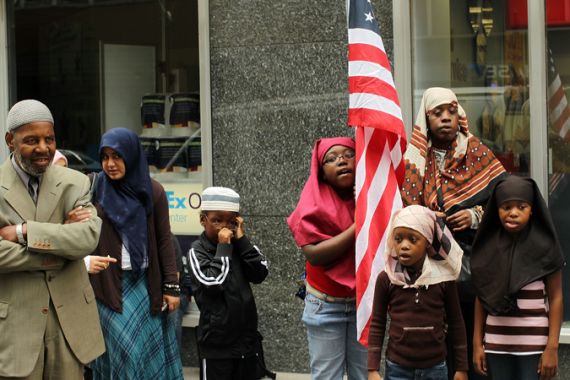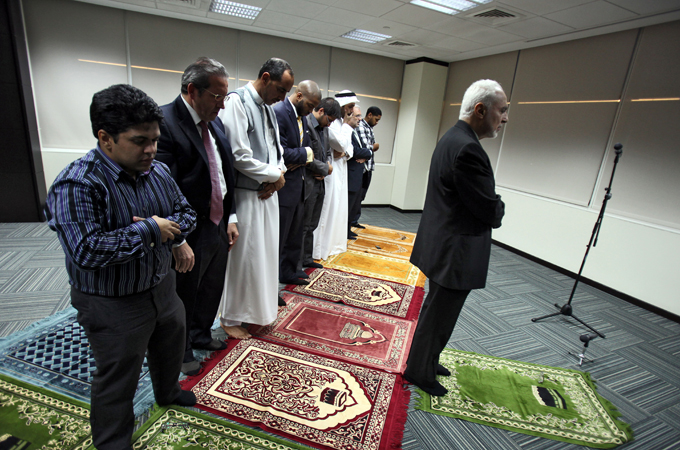Preventing violent extremism
A new US national strategy to counter domestic terrorism is more alarmist than useful.

 |
| Arab American Sufi Imam Feisal Abdul Rauf has tried to focus his talks on Islam in the United States and the fight against religious radicalism. [EPA] |
While sitting on a beach as part of my annual August pilgrimage to the family homeland in New England, I normally try to avoid anything even remotely strenuous, either physically or mentally. It was thus against my better judgment that I acceded this year to the entreaties of several journalists of my acquaintance to examine a new bit of wisdom recently promulgated by the US federal government – a “national strategy” to counter the threat of domestic violent extremism in the US, delivered with scant public fanfare and entitled “Empowering Local Partners to Prevent Violent Extremism.”
As its title would suggest, this new national strategy document is a real yawner. Barely eight pages in length and published in large print, the document nonetheless was over a year in the making. For this jaded former government bureaucrat, it was easy to see why. This is the sort of exercise that no self-respecting public servant with actual work to do – for instance, catching real terrorists – wants to waste her time on.
One might wonder, then, why anyone bothers to disseminate this boilerplate, or why anyone should take it seriously. In most circumstances, the preparation of such national strategies is just an inevitable part of the make-work of government. After all, there is no problem so small that the mighty US government is not expected to have some comprehensive strategy to deal with it, whether the threat is cancer, terrorism, childhood obesity or the dangers associated with undercooked shellfish. Violent extremism would surely make the cut.
But honestly, what more should the federal government in America be doing to counter violent extremism, whether international or domestic? Since 9/11, it has built a huge counter-terrorism intelligence infrastructure, reinforced cooperation with foreign intelligence and security partners around the world, and honed a special-operations capacity able not only to operate in active war zones, but capable of reaching into ungoverned spaces in far-flung corners of the globe.
On the domestic front, there are Joint Terrorism Task Forces in every major metropolitan area and in many smaller ones as well, and intelligence Fusion Centers in most states. Notwithstanding the challenge of sharing large amounts of information among many dozens of federal, state and local entities in a continental country, the mechanisms for doing so are constantly improving. And such is the ardent enthusiasm of the FBI for this task that a significant number of admittedly amateurish terrorist plots have been broken up under circumstances which suggest, as least, a degree of entrapment. Indeed, given the current climate of vigilance and scrutiny of the American Muslim community, anyone engaged in idle conversation with someone professing any degree enthusiasm for jihad should assume he is speaking with an FBI informant/provocateur.
Thought police
While any human activity can be improved upon, it is hard to imagine what else should be done, other than perhaps to mitigate the unhelpful consequences of over-zealous execution of the current policy. Remember, the threat being countered is hardly new, and has always been a crime. To go further, to attempt to intervene in an official capacity to counter attitudes and ideologies which fall short of criminal activity, points us down a long, dark tunnel which ends with the creation of a Thought Police.
Given this background, the new national strategy for countering domestic radicalisation is a suitably modest document. As its title clearly implies, the paper suggests that there is relatively little more that can be done from the centre, other than to facilitate and “empower” local governments and community organisations. Beyond platitudes and comparisons to past federal efforts to stimulate local programmes to counter criminal youth gangs, there are few specifics offered concerning how Washington would propose to implement this first pillar of the strategy. As a second pillar, the White House more usefully undertakes to build local government and law-enforcement expertise in understanding the phenomenon of individual radicalisation. Given the often ham-handed tactics of local law enforcement agencies typically quite ignorant of Islam, this can only be a good thing.
As for the final element of the national strategy – countering violent extremist propaganda – perhaps the less said, the better. Once again, not wishing to acknowledge or confront the past failings of US policy, the federal government instead chooses to treat negative feelings toward America in the broader Muslim community as though they were all based upon some colossal misunderstanding. Of such misunderstanding there clearly is much, but it begins with official American acts of omission and commission in the Islamic world. And as for promoting a “counter-narrative” to that put forward by Al Qaeda and other sympathetic groups, experience tells us that there is little that the government can usefully do beyond further extolling such classic American values as personal freedom and tolerance; any suggestion that the US should somehow engage on the detailed specifics of extremist interpretations of Islam gets into an area far beyond the appropriate province of a secularist government, and can only be counter-productive.
Perhaps the only interesting part of the national strategy is not what it says about the threat of violent extremism and how to counter it, but the frame of reference in which it places both the issue and the response. The document goes out of its way to put violent Islamic extremism into the broader historical context of analogous threats, and to stress that actions meant to counter radicalisation must both be consistent with American constitutional rights, and avoid unjustly stigmatising the US Muslim community.
This is hard to argue with: Or so I thought, until I saw the reactions to the document from some quarters, particularly in the Congress. It then became quite obvious why this new national strategy document was seen as a political necessity to produce in the first place, and why the White House presented it in such a careful way.
One might easily have anticipated the negative reactions from the American subculture of fringe counter-terrorism think tanks and terrorism-obsessed bloggers, for many of whom Islamophobia is never far from the surface.
Congressional alarmists
More disturbing, however, were the reactions of some of the usual suspects in Congress – particularly the redoubtable Representative Peter King, Chairman of the House Homeland Security Committee, infamous for the series of hearings he has recently chaired on the threats emanating from the US Muslim community and the allegedly inadequate response from community leaders.
“My concerns,” King stressed, “are with language in the report [that] suggests some equivalency of threats between Al Qaeda and domestic extremists, and also with the politically correct inference that legitimate criticism of certain radical organisations or elements of the Muslim-American community should be avoided.”
Mr. King’s politically-calculated prejudice against Muslims would be less outrageous if it were not for his past well-documented coddling of IRA terrorists. The extravagant understanding previously displayed by King, an ethnic Irishman, for the grievances of the Irish apparently does not cross cultural divides.
Of the US Muslim community, Rep. King intones darkly, “We must also remind its leaders that they must demonstrate leadership and cooperation.” One is tempted to ask, “Or else what, Congressman?”
Those concerns were simultaneously echoed by Senators Joe Lieberman and Susan Collins. “We continue to be disappointed” they noted earnestly in a joint statement, “that the administration remains reluctant to identify violent Islamist extremism as the main cause of the homegrown terrorist threat.”
Lieberman, perhaps Congress’ most hawkishly enthusiastic proponent of large-scale military action in Afghanistan, is also, not entirely coincidentally, the most slavishly unquestioning legislative supporter of Israel. It appears that his pious concern for the threat posed by Islamic extremism does not extend to support of the potential palliative of minimal justice for the Palestinians. For her part, Senator Collins’ signal contribution to US national security has been to author legislation saddling the American intelligence structure with yet more layers of useless, deadening bureaucracy.
Both Lieberman and Collins understand, however, that the best way to generate enthusiastic government action for policing thoughts and attitudes in the US Muslim community is to set up someone to blame if and when there is a future domestic terror incident: “The administration must now quickly produce an implementation plan showing what specific actions should be taken and by whom, who is in charge, what resources are needed, and how to assess progress in countering the terrorist ideology. A detailed implementation plan that focuses on violent Islamist extremism – the greatest threat we face today – is necessary for effective and efficient government action.”
Make no mistake. There is indeed a domestic threat of Islamically-inspired terrorism in the US. And some young, impressionable Americans are not immune to the blandishments of extremists who advocate unjustified and unjustifiable violence against their fellow citizens. But “the greatest threat we face?” This sort of demagoguery from the Peter Kings and Joe Liebermans will not make Americans safer.
Indeed, much the opposite. If there is a justifiable concern about at-risk Muslim youth in the US, nowhere is that concern greater than among the families and associates of those youth. They are only likely to come forward with their concerns and suspicions if they have trust in the intentions of local authorities, and confidence that they and their communities will not be further stigmatised as a result. Much harm has already been done through the many instances where upstanding individuals and benign Muslim institutions in the US have been raided and legally harassed on the basis of thin evidence and unjustified suspicion.
I had little enthusiasm for the promulgation of gratuitously obvious “national strategies” while in government, and have no greater enthusiasm for them now. But if a statement from the White House can do something, even marginally, to hold the braying Islamophobes in the US Congress and elsewhere at bay, then I am all for it.
Robert Grenier is a retired, 27-year veteran of the CIA’s Clandestine Service. He was Director of the CIA’s Counter-Terrorism Center from 2004 to 2006.
The views expressed in this article are the author’s own and do not necessarily reflect Al Jazeera’s editorial policy.
